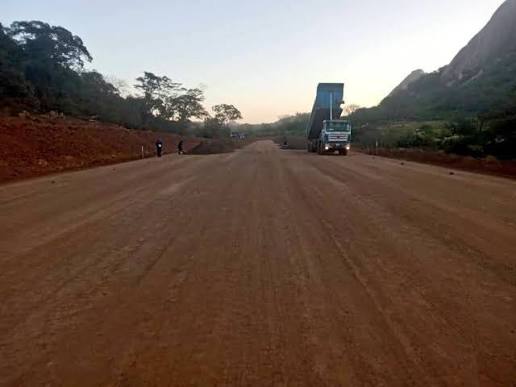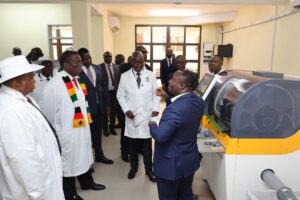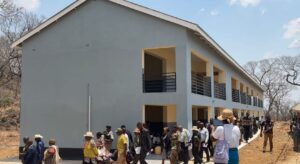Brick-by-Brick: Transforming Zimbabwe’s Southern Transport Corridor
4 min read
Ngundu – Brick by brick, kilometre by kilometre, Zimbabwe’s vision of a modern, safe, and efficient national road network is taking shape.
The Harare–Masvingo–Beitbridge Road Rehabilitation and Upgrading Project, one of the nation’s most ambitious infrastructure undertakings, continues to gather momentum — with a new 16-kilometre dualisation stretch now underway in the Ngundu section.
This milestone marks yet another chapter in the steady transformation of one of Zimbabwe’s most strategic arteries under the astute leadership of His Excellency the President Dr. ED Mnangagwa — a lifeline that connects the capital, Harare, to the southern border at Beitbridge, and further to the wider Southern African region.
The road is not just a local route; it is a vital regional trade corridor linking Zimbabwe to South Africa, Zambia, Mozambique, and beyond.
The Harare–Masvingo–Beitbridge highway carries a heavy load — both literally and economically. Serving as the main gateway for trade and transport between Zimbabwe and its largest trading partner, South Africa, this corridor handles thousands of vehicles daily, including haulage trucks ferrying imports and exports.
The importance of this route extends beyond commerce. It supports tourism, agriculture, manufacturing, and logistics.
From farmers in Masvingo delivering produce to the capital, to tourists traveling to Great Zimbabwe or further south to Beitbridge, this road underpins daily life and economic activity across provinces.
Recognising its significance, the Government of Zimbabwe included the rehabilitation and upgrading of this corridor among its top infrastructure priorities under the National Development Strategy 1 (NDS1).
The goal is clear: modernise the country’s transport infrastructure to promote industrialisation, regional integration, and socio-economic development.
The current works on the Ngundu section represent a continuation of the broader dualisation programme aimed at improving safety, efficiency, and traffic flow.
The 16-kilometre dualisation underway will expand the road to two lanes in each direction, reducing congestion and minimising the risk of head-on collisions, a persistent concern on older single carriageways.
Contractors on site are engaged in intensive earthworks, drainage installation, and base layer preparation.
Once complete, the new section will feature modern road signage, improved shoulders, and upgraded intersections — all designed to meet international standards for regional highways.
Residents and road users in the surrounding areas have already begun to feel the benefits. Reduced travel times, fewer traffic jams, and improved accessibility are just some of the early signs of progress.
For local businesses, especially those operating near growth points such as Ngundu, the improved road has the potential to attract new investment, enhance trade, and spur local economic activity.
The Harare–Masvingo–Beitbridge project is not just about asphalt and concrete — it is about building a safer and more reliable future for Zimbabwe’s road users.
For decades, the highway was notorious for accidents, many of them fatal, due to narrow lanes, poor visibility, and high traffic volumes.
The dualisation effort aims to drastically reduce such risks by separating opposing traffic flows and improving road geometry.
Moreover, efficiency gains from a dualised highway cannot be overstated. Shorter transit times mean lower vehicle operating costs, reduced fuel consumption, and faster movement of goods and people.
For the transport and logistics sector, which forms a critical backbone of Zimbabwe’s economy, such improvements translate directly into competitiveness and profitability.
Beyond the engineering achievements, the project also carries strong socio-economic benefits.
Hundreds of local workers have been engaged across different phases, providing employment, training, and skills development.
Small and medium enterprises (SMEs) in nearby towns have benefited through supply contracts, accommodation services, and catering for construction crews.
The inclusion of local participation aligns with the government’s policy of ensuring that large-scale public works projects stimulate domestic economic activity rather than merely import external expertise.
It is a philosophy grounded in the belief that every brick laid should not only build a road — but also build communities, livelihoods, and capacity.
Zimbabwe’s Vision 2030, which seeks to transform the nation into an upper middle-income economy, identifies infrastructure development as a key enabler of growth.
The Harare–Masvingo–Beitbridge Road embodies this vision in motion. It demonstrates how strategic investment in public works can unlock opportunities across multiple sectors — from trade and tourism to manufacturing and agriculture.
The road’s completion will complement other ongoing regional infrastructure efforts, including the modernisation of the Beitbridge Border Post and the rehabilitation of connecting feeder roads.
Together, these initiatives are reshaping the transport landscape and positioning Zimbabwe as a competitive transit hub in the region.
For many communities along the route, the project is more than a technical exercise — it’s a promise being fulfilled.
“We’ve waited years for this. The new road brings hope,” says a shop owner in Ngundu. “It’s already changing the way people travel, and we’re seeing more business as traffic moves more smoothly.”
Truck drivers, too, have praised the improvements. “This road used to be a nightmare,” says a long-distance driver who frequently plies the Harare–Beitbridge route. “Now, with the dualisation, driving feels safer and faster. You can see the difference.”
Looking ahead, the Ministry of Transport and Infrastructural Development has reaffirmed its commitment to completing all sections of the project in line with the national transport master plan.
Once fully dualised, the Harare–Masvingo–Beitbridge Road will not only meet the demands of today but also serve as a resilient backbone for the movement of goods and people well into the future.
Brick by brick, kilometre by kilometre, the transformation continues. The ongoing dualisation at Ngundu is more than just a construction site — it is a visible symbol of Zimbabwe’s determination to build, modernise, and grow.
As bulldozers move earth and engineers lay fresh tar, they are not merely paving a highway — they are paving a path toward a more connected, prosperous, and inclusive Zimbabwe.
Indeed, the Harare–Masvingo–Beitbridge Road stands as a testament to what can be achieved when vision meets action — one stretch at a time.




